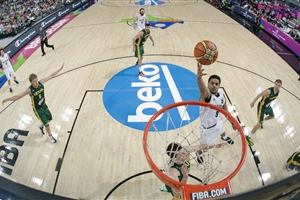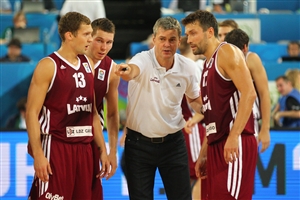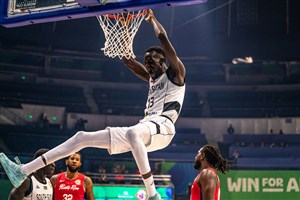
The Best of Basketball in the Americas in 2014 - Part 1
SAN JUAN (William Rosario's Somewhere in the Americas) - It's wrap-up season. Time to reminisce about the great year it has been for basketball in the Americas. And it has been truly great, full of moments that can be used as proof of the growth of our sport in the continent.
It all started with the 2014 Liga de las Americas and a dominating performance from the biggest club in Brazil, Flamengo from Rio de Janeiro. The Brazilian squad opened up the seventh season of the continental league against Capitanes de Arecibo of Puerto Rico, a perennial powerhouse in the competition and ended up beating them 123-90.
They ended up going undefeated throughout the competition, with an average margin of victory of 19.7 points per game. Winning the championship won them the opportunity of facing the Turkish Airlines Euroleague champions Maccabi in the Intercontinental Cup (which I will come back to in the second part of these greatest hits of 2014).
It was beautiful to watch a sold out 10,000 seat Maracanazinho arena full of Flamengo fans jumping up and down with excitement in celebration of their team's triumph. It served as confirmation that this continental league which began as an experiment in 2007 was here to stay. The club competition context has given FIBA basketball in the Americas the best crowds in recent years. It has made FIBA basketball better in the eyes of the audience in our continent and that alone makes it worthy.
Then came the FIBA Americas U18 Championship and once again it delivered. The continental youth tournament did what it has historically done best - put the superstars of the future in full display.
At the Americas level this is the rare opportunity basketball gives us to see USA Basketball and this year's team was simply impressive. Other than the fact that they dominated as usual, with an average margin of victory of 54.8 points per game, their roster was stacked with so much talent that it was a scout's dream.
And having the tournament played in Colorado made it easier for them to come down to watch a squad that had three seven-footers in (now college star) Myles Turner, Stephen Zimmerman and late-addition Chase Jeter.
They were all great, but without a doubt the standout of the championship was Justice Winslow, who looked like one of those players built to play with the senior men's team in Spain. He was powerful, quick and aggressive. Winslow is the complete package and is showing it precisely for Coach K at Duke University where he's shining in his freshman season.
There were other impressive players in the championship. Dillon Brooks and Montaque Gill-Caesar proved to be two more names to watch in an already incredible up-and-coming national team class for Canada. As we move closer to 2015, they are sure to be an important part of the conversation next year.
This FIBA Americas U18 only added to the expectation.
Argentinean point guard Jose Vildoza, Mexican big man Ivan Venegas and the Puerto Rican high-low pairing of Ivan Gandia and Arnaldo Toro are some of the other names to watch out the 2014 U18 class in the Americas.
The Women's Centrobasket confirmed what the 2013 FIBA Americas Women's Championship made clear: Cuba and Puerto Rico are the teams to take seriously in the Caribbean. Both were undefeated when they met each other in the final game of the competition. Puerto Rico specifically looked more cohesive this year with the come-back of Cindy Valentin to the team and the confirmation of Carla Cortijo as the sure fire star of the squad. But in the end, Cuba was just better, winning the tournament in consistent fashion and thanks to an amazing performance from their center Clenia Noblet, who scored 12 points and grabbed 23 rebounds in the victory.
The sour note of the championship though was a Mexican team that seemed to regress in comparison to years past finishing in fifth place in hosting duties. (They eventually would lose a 2015 FIBA Americas Championship qualifying two-game series against Ecuador and finish third in the Central American and Caribbean Games, both as the home team).
In contrast, the Men's Mexican team stayed solid and added to their great 2013 run, with a 2014 Centrobasket for the ages in Tepic, Nayarit. Led by Gustavo Ayon and head coach Sergio Valdeolmillos, the team brought basketball to a relevant place in Mexico's sport landscape and had the national team selling out every game of the championship. With more than 10,000 fans in the stadium every night, the Mexican national team looked untouchable with an organized and patient offensive system and a very physical defensive execution. The team went undefeated with Ayon averaging a double-double and leading the tournament in blocked shots.
The team then went on to advance to the second round of their first FIBA Basketball World Cup in 40 years and were eliminated by USA in a very honorable performance in Barcelona. Ayon had 25 points in the game and the team looked poised to have a historic 2015 as they host the continental championship and Olympic qualifier.
I say "looked" because Valdeolmillos was fired from the team immediately after the World Cup in a very controversial move by the national federation. Now Ayon is saying he does not want to play because of the decision, so the wave has crashed and Mexico seems to be in for a tough go as hosts in Monterrey next year. They were so close. At home, with the same team that played in Spain this year, they would have been the favorite to once again make history and make it to the Olympics.
So, Liga de las Americas, FIBA Americas U18, and the Men's and Women's Centrobasket… all great representations of the best basketball has to offer in the Americas at every level (club competition, youth, Women and Men’s national team).
I still have the South American Championship, the FIBA Americas U18 for Women, the FIBA Basketball World Cup, the FIBA World Championship for Women and the Sudamericana to look back on next week.
2014 was great indeed.
William Rosario
FIBA
FIBA's columnists write on a wide range of topics relating to basketball that are of interest to them. The opinions they express are their own and in no way reflect those of FIBA.
FIBA takes no responsibility and gives no guarantees, warranties or representations, implied or otherwise, for the content or accuracy of the content and opinion expressed in the above article.

















